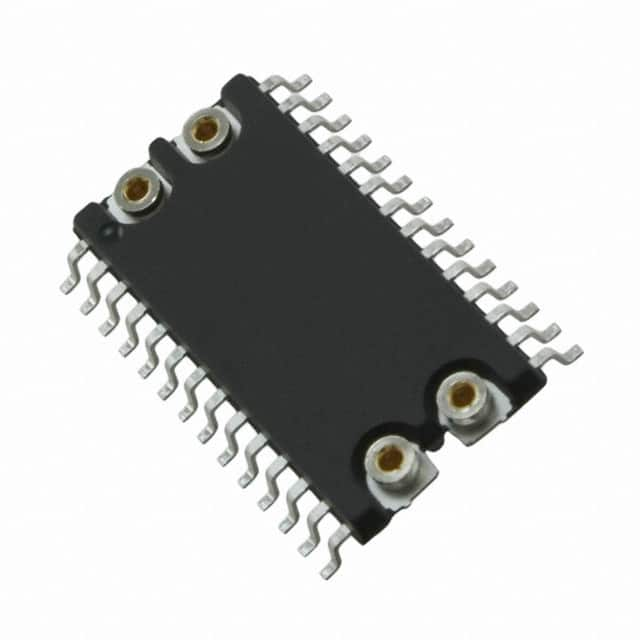M48Z58Y-70MH1E
Product Overview
Category
M48Z58Y-70MH1E belongs to the category of non-volatile static random access memory (NVSRAM).
Use
This product is primarily used for storing critical data in applications that require non-volatility, such as real-time clocks, industrial automation systems, and power meters.
Characteristics
- Non-volatile: The M48Z58Y-70MH1E retains data even when power is removed.
- High density: It offers a storage capacity of 64 kilobits.
- Low power consumption: The device operates with low power requirements, making it suitable for battery-powered applications.
- Reliable: The NVSRAM technology ensures data integrity and endurance.
Package
The M48Z58Y-70MH1E comes in a compact 28-pin SOIC (Small Outline Integrated Circuit) package.
Essence
The essence of M48Z58Y-70MH1E lies in its ability to combine the benefits of both SRAM (fast read/write access) and non-volatile memory (data retention without power).
Packaging/Quantity
This product is typically packaged in reels containing 250 units per reel.
Specifications
- Supply voltage: 4.5V to 5.5V
- Operating temperature range: -40°C to +85°C
- Access time: 70ns
- Standby current: 100μA (typical)
- Data retention: 10 years (minimum)
Detailed Pin Configuration
The M48Z58Y-70MH1E has the following pin configuration:
- Chip Enable (CE)
- Output Enable (OE)
- Write Enable (WE)
- Address Inputs (A0-A13)
- Data Inputs/Outputs (DQ0-DQ7)
- Ground (GND)
- 5V Power Supply (VCC)
- Not Connected (NC)
Functional Features
- Battery backup: The M48Z58Y-70MH1E includes an integrated lithium energy source, ensuring data retention during power loss.
- Automatic write protection: The device features a built-in write protect function to prevent accidental data modification.
- High-speed access: With a fast access time of 70ns, the M48Z58Y-70MH1E enables quick read and write operations.
Advantages and Disadvantages
Advantages
- Non-volatile memory ensures data integrity during power interruptions.
- High-density storage capacity.
- Low power consumption.
- Reliable operation in harsh environments.
Disadvantages
- Relatively higher cost compared to traditional SRAM.
- Limited storage capacity compared to other non-volatile memory technologies.
Working Principles
The M48Z58Y-70MH1E combines a static random access memory (SRAM) array with a non-volatile element. When power is applied, the device operates like a standard SRAM, allowing fast read and write operations. However, when power is removed, an integrated lithium energy source takes over, providing the necessary power to retain data in the SRAM array.
Detailed Application Field Plans
The M48Z58Y-70MH1E finds applications in various fields, including:
- Real-time clocks: The non-volatile nature of this NVSRAM makes it ideal for storing timekeeping data in real-time clock modules.
- Industrial automation systems: Critical data, such as configuration settings and process parameters, can be stored reliably in the M48Z58Y-70MH1E.
- Power meters: This NVSRAM can store energy consumption data even during power outages, ensuring accurate billing information.
Detailed and Complete Alternative Models
- M48Z58Y-70MH6E: Similar to the M48Z58Y-70MH1E, but with a higher storage capacity of 512 kilobits.
- M48Z58Y-70MH3E: A lower-cost alternative with a reduced storage capacity of 32 kilobits.
These alternative models offer different storage capacities and may suit specific application requirements.
In conclusion, the M48Z58Y-70MH1E is a non-volatile static random access memory that combines the benefits of SRAM and non-volatile memory technologies. With its high density, low power consumption, and reliable operation, it finds applications in various fields such as real-time clocks, industrial automation systems, and power meters. Alternative models with different storage capacities are also available to cater to specific needs.
قم بإدراج 10 أسئلة وإجابات شائعة تتعلق بتطبيق M48Z58Y-70MH1E في الحلول التقنية
Sure! Here are 10 common questions and answers related to the application of M48Z58Y-70MH1E in technical solutions:
Q1: What is the M48Z58Y-70MH1E? A1: The M48Z58Y-70MH1E is a non-volatile static RAM (NVSRAM) module with a real-time clock (RTC) that provides battery backup for data retention.
Q2: What is the purpose of using M48Z58Y-70MH1E in technical solutions? A2: The M48Z58Y-70MH1E is commonly used to store critical data, such as configuration settings or system parameters, that need to be retained even when power is lost.
Q3: How does the M48Z58Y-70MH1E retain data during power loss? A3: The M48Z58Y-70MH1E has an integrated lithium battery that powers the SRAM cells, ensuring data retention even when the main power supply is disconnected.
Q4: Can the M48Z58Y-70MH1E be used in battery-powered devices? A4: Yes, the M48Z58Y-70MH1E is suitable for battery-powered devices as it consumes very low power and can operate on a wide voltage range.
Q5: What is the capacity of the M48Z58Y-70MH1E? A5: The M48Z58Y-70MH1E has a capacity of 64 kilobits (8 kilobytes) of non-volatile memory.
Q6: Is the M48Z58Y-70MH1E compatible with standard microcontrollers or processors? A6: Yes, the M48Z58Y-70MH1E uses a standard parallel interface and can be easily interfaced with most microcontrollers or processors.
Q7: Can the M48Z58Y-70MH1E be used in harsh environments? A7: The M48Z58Y-70MH1E is designed to operate in a wide temperature range and is suitable for use in industrial or automotive applications.
Q8: How long does the battery of the M48Z58Y-70MH1E last? A8: The battery life of the M48Z58Y-70MH1E is typically around 10 years, ensuring long-term data retention.
Q9: Can the M48Z58Y-70MH1E be easily replaced if the battery runs out? A9: No, the M48Z58Y-70MH1E is a sealed module, and the battery cannot be replaced. However, it has a long lifespan that should cover most applications.
Q10: Are there any special considerations when using the M48Z58Y-70MH1E in circuit designs? A10: It is important to ensure proper decoupling and power supply stability for reliable operation. Additionally, attention should be given to the backup battery voltage monitoring to prevent data corruption.
Please note that these answers are general and may vary depending on specific application requirements.


